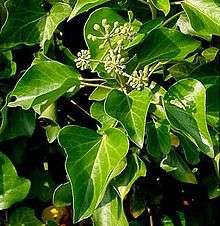Hedera hibernica
| Hedera hibernica | |
|---|---|
 | |
| Hedera hibernica shoot with flower buds | |
| Scientific classification | |
| Kingdom: | Plantae |
| (unranked): | Angiosperms |
| (unranked): | Eudicots |
| (unranked): | Asterids |
| Order: | Apiales |
| Family: | Araliaceae |
| Genus: | Hedera |
| Species: | H. hibernica |
| Binomial name | |
| Hedera hibernica (G.Kirchn.) Bean | |
| Synonyms[1] | |
| |
Hedera hibernica (common name Atlantic ivy or Irish ivy) is a woody vine native to the Atlantic coast of Europe.
Description
It is an evergreen climbing plant, growing to 20–30 m high where suitable surfaces (trees, cliffs, walls) are available, and also growing as ground cover where there are no vertical surfaces. It climbs by means of aerial rootlets which cling to the substrate. Native to the Atlantic region, it has been cultivated and can appear in the wild outside its original area, along the Atlantic coast from Portugal, Spain, France, British Isles, Germany, Scandinavian countries, and Baltic Sea.
The bark is first green, but soon after it becomes gray. Old branches are light gray with a finely furrowed bark. Buds are almost hidden by the leaf base, egg-shaped and bright green. The leaves have entire margins and are ovoid or with five triangular lobes. The surface is glossy dark green with light ribs, while the underside is pale green. The leaves of flowering shoots are, however, oval with entire margins. Flowering occurs in September-October. The fruits are blue-black berries. The whole plant and also the berries are slightly poisonous.
The plant has an attractive and elegant aspect. It is quite common in gardening, and has gained the Royal Horticultural Society's Award of Garden Merit.[2] Like the related H. helix (English ivy), H. hibernica is an invasive weed in parts of North America with mild winters: in a recent study, 83% of 119 populations of invasive ivy sampled in the Pacific Northwest were found to be H. hibernica and not H. helix as was previously thought.[3] In fact it can be troublesome in any garden, rapidly colonising hedges, trees and borders if not kept in check.
Ecology
It may be a noxious weed or be invasive. It requires consistently moist soil, and can grow in any light environment from full sun to deep shade. Its natural habitat is forest or dense bush which is cool and cloud-covered for much of the year, such as is often found in mountainous regions near the ocean. It prefers well-drained or alkaline soils rich in nutrients and humus.
References
- ↑ "The Plant List".
- ↑ "Royal horticultural Society".
|chapter=ignored (help) - ↑ D. J. Metcalfe, "Hedera helix L." Journal of Ecology 93 (2005), 632–648; cited in The Ivy Files (City of Portland website; last accessed 16 March 2014)